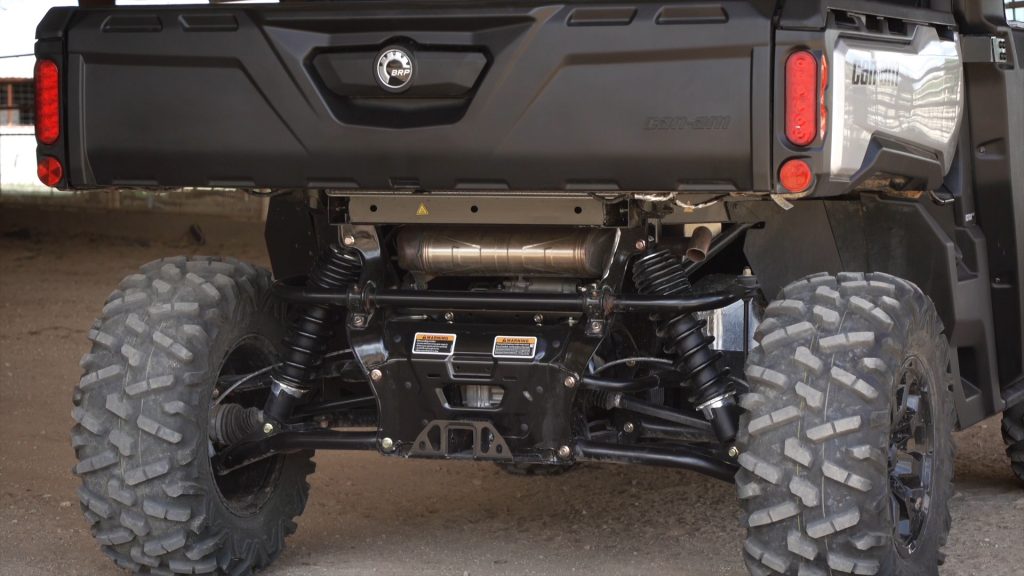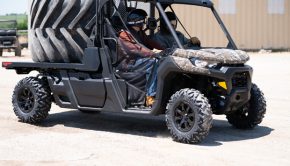Published on June 8th, 2020 | by Joe
2020 Can-Am Defender Limited Test: WITH VIDEO
Time is money, and time taken off from working or enjoying your SXS due to inclement weather is money lost. For 2020, Can-Am has released the HVAC equipped Defender Limited, a machine that makes it not only possible, but pleasurable to get out in the worst of conditions.
The Defender Limited is available exclusively with Can-Am’s 1000cc class HD10 engine, boasting a gain of 10hp and 9 ft-lb of torque compared to 2019. We sent Senior Testing Correspondent and CT Racing Engine’s owner, Allen Knowles, to the Wild Ranch in Texas to test the climate controlled world of the Defender Limited and give us a review of its performance.
The Defender Limited Package Special Features
The Defender Limited benefits from Can-Am’s 1000cc class HD10 engine, in addition to its sophisticated cab enclosure system and other XT package features including a 4,500 lb winch, steel bumper, and reinforced seat cover. What sets the Defender Limited apart from the Defender XT Cab is the additional AC and auto climate mode, limited color seats and badges, a 7.6” display with keypad, and LED signature driving lights.
Updated HD10 Engine
At the heart of the Defender Limited HD10 is a fuel-injected, liquid cooled, HD10 V-twin engine displacing 976cc producing 82hp and 69 ft-lb of torque for 2020. A new exhaust system reduces sound output.
A drive-by-wire gas pedal works with the Intelligent Throttle Control to reduce unwanted pedal inputs; the Defender HD10 offers 3 throttle modes. Normal mode is optimized for recreational driving with no limitations on power. ECO mode reduces high range speed and torque and was revised for 2020 to deliver a smoother driving experience at a moderate pace. Work is calibrated for working with high loads at lower speeds to provide smooth power delivery with no restriction on power or torque.

At the heart of the Defender Limited HD10 is a fuel-injected, liquid cooled, HD10 V-twin engine displacing 976cc producing 82hp and 69 ft-lb of torque for 2020. A new exhaust system reduces sound output.
The Defender’s fully automatic PRO-TORQ, CVT transmission comes equipped with Can-Am’s Quick Response System for fast, smooth low RPM engagement. It features park, reverse, neutral, high, and extra low forward ranges with a gear selector located on the dash. Extra low is specifically designed to handle heavy loads while pushing or pulling at low speeds.
With the increase in torque, Can-Am reduced the CVT’s shift point by 500 RPMs allowing the engine to operate at a lower RPM under heavy acceleration reducing noise and, possibly, fuel economy.
The drive train features selectable 2WD and 4WD with Can-Am’s auto locking Visco-Loc QE, (quick engaging) front differential, which automatically locks up the front differential if one front tire begins slipping, disengaging it when traction is restored. Turf Mode is also available, unlocking the rear differential to prevent damaging sensitive turf. Electronic Hill Descent Control adds engine braking in all three throttle modes.
Low-end and midrange power is plentiful for getting work done or recreational driving. Top end is good, but obviously not quite on par with a sport machine. Allen had the Defender over 60mph allowing you to make quick work of wide open spaces. While not an incredibly fast revver, the engine exceeded our expectations when it came to fun factor.
Low RPM clutch engagement is smooth and predictable. Back shifting performance is good when getting in and out of the throttle. High range performance works fine for all but the lowest of speeds, with plenty of top-speed for the vehicle’s intended use. Extra low range performance seemed ideal for an extremely low speed trail section or getting work done. Engine braking felt strong and well suited to the Defender’s work focused intentions.

Extra low range performance seemed ideal for an extremely low speed trail section or getting work done.
Chassis and Suspension

The Defender’s steel chassis mates up to a ROPS approved cage up top. A steel XT bumper front and UHMW full chassis skid plate underneath add protection.
The Defender’s steel chassis mates up to a ROPS approved cage up top. A steel XT bumper front and UHMW full chassis skid plate underneath add protection. Suspension consists of Dual A-Arms up front and Torsional Trailing Arms out back. The lower front arms and trailing arms are arched to maximize ground clearance. Twin-tube, gas charged shocks feature notched preload adjustment controlling 10” of suspension travel at both ends. Sway bars at both ends help control body roll.

Twin-tube, gas charged shocks feature notched preload adjustment controlling 10” of suspension travel at both ends. Sway bars at both ends help control body roll.
Mounted on 14” cast aluminum wheels are 27x9x14” front and 27x11x14” rear Maxxis Bighorn 2.0 tires, which perform well in most environments and keep rotating mass down to maintain engine performance. Suspension travel and tire size add up to 12” of ground clearance.
The Defender is a claimed 65” wide with an 83” wheelbase and 12” of ground clearance. Overall length is 126” with a 79” overall height and an estimated dry weight of 1,928 lb.
The Defender is extremely plush and forgiving over small to medium size bumps; while it’s not quite ideal for big whoops or g outs at high-speed, the suspension is well suited for long work days or trail riding.

Steering is a bit on the slow and pickup truck like, making it less overwhelming for less experienced drivers who might be using the Defender for work.
Steering is a bit on the slow and pickup truck like, making it less overwhelming for less experienced drivers who might be using the Defender for work. The more manageable steering ratio worked with the steering wheel, which is mounted high on the dash. Steering precision was very accurate allowing you to put the car exactly where you wanted. Power steering keeps steering light, doing well at eliminating bump feedback.

In spite of the Defender’s plush, forgiving suspension, body roll wasn’t an issue thanks to its dual sway bars.
In spite of the Defender’s plush, forgiving suspension, body roll wasn’t an issue thanks to its dual sway bars. The power and stability allowed us to drift a bit and drive the Defender more aggressively than its marketed intentions would indicate.
Over smooth to mildly bumpy terrain, high-speed stability was very good. Allen was very impressed with the Defender’s climbing and descending manners.
Brakes
The engine braking backs up four-wheel hydraulic disc brakes with 220mm vented rotors at all four corners. Dual-piston calipers are used up front with single piston calipers used out back.
Braking power and feel were up to the task of Allen’s slightly over aggressive driving, scrubbing off speed and holding the Defender back on steep descents. Braking performance was far and above what we experienced on early Maverick models.

Braking power and feel were up to the task of Allen’s slightly over aggressive driving, scrubbing off speed and holding the Defender back on steep descents.
Interior with new HVAC system and other details
The biggest news for the Defender Limited is the addition of air conditioning accompanied by a number of other upgrades to the HVAC system and interior. Sealing of the doors and electronically controlled windows was improved to keep dust out, backed up by a cabin air filter system. For times when you want to feel the wind in your face, there’s a sealed 3 position flip-up glass windshield complete with a windshield wiper.
The HVAC system delivers a new aluminum heater system for improved heat conduction and transfer, and is said to deliver 50% hotter air temperatures at full capacity. The new air conditioner uses a variable compressor that’s not linked with the engine to deliver better performance at low RPMs. It’s also said to reduce fuel consumption and horsepower loss.

In addition to allowing you to manually control the temperature, auto climate mode allows you to set a temperature that is automatically maintained through the use of the heater and air conditioner.
In addition to allowing you to manually control the temperature, auto climate mode allows you to set a temperature that is automatically maintained through the use of the heater and air conditioner.
Can-Am’s Versa-Pro bench seat features a reinforced XT seat cover with a flip-up passenger and adjustable driver’s seat accompanied with a tilt adjustable steering wheel. Can-Am’s orange backlit displays are easy to read. The thicker sealed front and rear firewalls with integrated heat shield reduce unwanted heat transfer into the cabin and work with the revised exhaust to reduce noise.
There’s 12.7 gallons of storage in the unit with a 2 gal box in the dash, waterproof and removable 5.6 gal box under the passenger seat, 1.6 gal storage box under the dash, .9 gal of storage in the armrests and cup holders, .8 gal in the interior doors, and 1.7 gal in a water-resistant and removable toolbox.
Locating items inside the cabin is made easier with a roof mounted dome light. Exterior lighting provides 140 W of output with four 35 W reflector headlights with signature LED running lights up front and LED taillights found out back.
The Limited is easy to get in and out of, similar to a mid-size pickup. Seating comfort is similar to what you might find in a decent work pickup. It seats three full-size adults, but would be more comfortable for long hauls with two. Leg room is plentiful, even for taller occupants. Placement of the steering wheel, shifter, and other controls are all well placed.
The slightly utilitarian interior offers a good level of refinement throughout the different touch points and switches.
With its cab and HVAC as the highlights of the Defender Limited, we are happy to report that the air conditioner was extremely effective at keeping the cab cool in the hot Texas sun. With the increased heating capacity, cold nights shouldn’t be a problem either. The vents are intelligently located, allowing you to direct airflow on or away from occupants as desired.
Work Capability

Dimensions of the hydraulically assisted dump bed are a claimed 38” long, 54.5” wide, and 12” deep with a 1,000 lb capacity.
Dimensions of the hydraulically assisted dump bed are a claimed 38” long, 54.5” wide, and 12” deep with a 1,000 lb capacity. A 2” hitch receiver with a 2,500 lb payload capacity provides convenient truck to SXS hitch transfer. The Defender’s 4,500 lb winch takes work capability to the next level for raising and lowering plows in addition to helping get the Defender, or other vehicles, out of sticky situations. Of course, the Limited’s cab and HVAC system make work much more enjoyable throughout the seasons.

The Defender’s 4,500 lb winch takes work capability to the next level for raising and lowering plows in addition to helping get the Defender, or other vehicles, out of sticky situations.
We’d like more time to load down and tow with the Defender; however, based on its build quality and extremely competitive hauling and towing capacities and design, we’re quite confident in its ability to get some serious work done.

A 2” hitch receiver with a 2,500 lb payload capacity provides convenient truck to SXS hitch transfer.
Conclusion
Although the Defender Limited is designed as a work and recreation vehicle, we feel it eclipses the performance of sport SXS from a decade ago. It’s a serious work machine delivering a good amount of performance for exploring and trail cruising. Starting at $25,199, the Defender Limited costs around 27% more than the $18,499 Defender XT HD10, which we believe is a small price to pay for a money making work machine that can be operated comfortably for long hours year round. If you’re considering an HD10 equipped XT Cab for only $1,000, we’d say the air conditioned, better appointed Defender Limited is a no brainer.
With both SXS and ATV publications under our umbrella, we’ve been happy with Can-Am’s performance and modern, refined appearance and design. We are certainly impressed with Can-Am’s line of work SXS, including the all-weather Defender Limited.
2020 Can-Am Defender Limited Ratings
Summary: It’s a serious work machine delivering a good amount of performance for exploring and trail cruising. Starting at $25,199, the Defender Limited costs around 27% more than the $18,499 Defender XT HD10, which we believe is a small price to pay for a money making work machine that can be operated comfortably for long hours year round. If you’re considering an HD10 equipped XT Cab for only $1,000, we’d say the air conditioned, better appointed Defender Limited is a no brainer.













